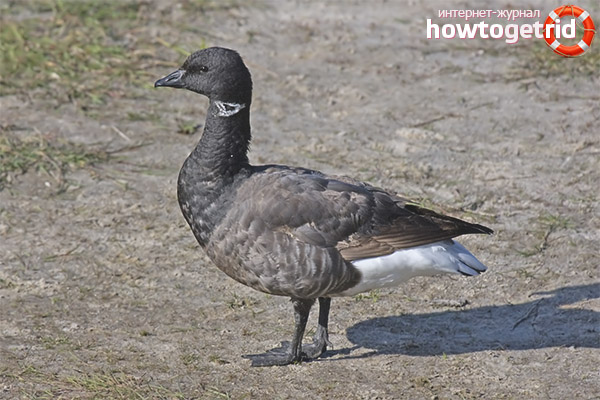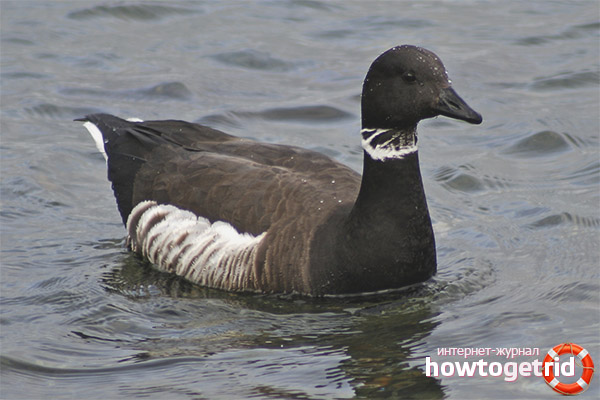The content of the article
The flight of the black geese is of extraordinary beauty. The bird is part of the genus Branta and is its smallest representative. During the flight, this feathered representative can overcome a distance of thousands of kilometers, although, at first glance, its flight is very difficult. In flight, the bird often flaps its wings. During migration, the shape of the pack has a wavy line. The height from the ground during a migration flight is small. It carries out local movements in the form of a close heap, flying at an insignificant height from the ground or water. The flight is accompanied by the publication of characteristic low-pitched screams.
It lives on the Arctic Circle. It can be found on the coast of the Arctic seas, islands located in the Arctic Ocean.
External data
The variability of geography leaves its mark on the coloring of the body from the upper and lower sides. The bird carries out migratory flights in two directions. This circumstance allows us to distinguish two groups. One of them includes representatives who show a craving for the northern shores of the Atlantic Ocean, and the direction of flight of birds of the other group is the Pacific Ocean.
This bird is the smallest of all geese. Its size approaches the size of a domestic duck. In length, the body can reach 69 cm, and weight - about 1.8 kg. The bird is characterized by the presence of three subspecies. Their differences are in coloring. In adulthood, the bird has a black head, chest and neck. The back has a dark gray color with a black border. The body below and on the sides is gray.
The dimensions of the males are slightly larger than that of females. Young birds do not have a white collar, which is characteristic of a juvenile outfit with a general brownish tone of plumage. In the second year of bird life, the disappearance of brownish plaque is noted. But in return, his bird is characterized by the appearance of a white collar. During this period, the formation of puberty is not yet complete.
Paws and beak are painted black in birds. She got her name not by accident. It was the black color that gave the reason for the bird to be called that way.
This goose is characterized by a very silent manner of behavior. If the bird begins to say something, then its speech is like a nasal murmur. During the flight, the bird's voice can be heard only when it is at a close distance from the person.
Prevalence
Representatives of this species can be found in Western Europe on its northern coast. She lives in the north of Germany, Denmark, the Netherlands. But the distribution area is not limited only to these countries. It can also be found in the southeast of the British Isles. It is found on the French coast of the Atlantic. In our country, its habitat is Chukotka and Yakutia.
Now in the wild there are about half a million representatives of this species. A sharp decline in numbers could be observed in the 70s of the last century. This was due to the absence of a ban on hunting them. Hunting is currently prohibited, but the threat of species decline remains. This is due to the fact that bread fields are a favorite place for grazing goose. It is easy to guess that they, therefore, become an object for extermination.
Subspecies
The bird has three subspecies. Each of them has a black color, but with a difference in color on the sides and belly:
- Branta bernicla hrota. The subspecies has a light belly and a pale brown shade of feather color. Goose nesting of this subspecies is carried out in Canada. Greenland with its nearby islands is also a nesting place. This subspecies prohibited any hunting.
- Branta bernicla nigricans. Birds with a black belly. Nesting is carried out in North America, in our country - in the Siberian open spaces.
- Branta bernicla bernicla. Representatives of this subspecies have a dark belly. Nesting is carried out in the northern European and Asian territories.
Habitat
The habitat of black geese is the northern tundra. It can also be found in moist meadows, where there is low grassy vegetation. Nests are arranged on gentle shores, abundantly covered with salt marshes. But she can also make nests where there are grassy islands. Usually their location is connected with the river delta and ponds.
A favorable environment for its habitat is the coastal strip of water bodies. During the migration flight, the bird stops to rest in places where there are flooded silty shores. Undoubtedly, fields with cereal crops are of interest to birds.
Lifestyle characteristics
This species is characterized by pronounced migration. A flock during migration has a fairly good density. The flight speed of the birds is considerable and can reach 90 km per hour. Such high speed indicators are achieved by the presence of her long and narrow wings. Along with seasonal flights, migrations during the day are possible. At the feeding place the bird is a couple of hours, and then flies away towards the sea for watering. There they will be until the middle of the day. At this time, they drink water and rest.
From the afternoon they again set off in search of food on the coast and spend time there before sunset. The place of their overnight stay is the open sea.
Breeding
For the purpose of reproduction, birds are kept in pairs. Small colonies form from the formed pairs. The appearance of chicks occurs almost simultaneously. For the first time, the chicks that appeared just do what they eat. It takes them up to 13-14 hours a day to feed. This will continue until the chicks fledge. They spend the winter with their parents. A sexually mature individual is formed in 2-3 years.
Nesting near the pond. There are examples of brood in ice tundra. The bird builds nests from various vegetation in combination with its own fluff. Basically, the female can lay 3-5 eggs. In very rare cases, their number can reach up to seven pieces. The female hatches eggs for 24-26 days.
The ritual of male courtship of a female is very complex in nature. These birds form one pair for life. Mate in the water.
Captive feeding
A bird needs a sufficient amount of feed consisting of plant components for nutrition. In addition, in the diet of young birds use germinated grain. Favorite treat - salad. If the grass in the aviary is unsuitable for food, a certain amount of freshly cut grass is added to the diet. They also provide compound feed intended for hens, as well as pellets intended for feeding waterfowl representatives.
Video: Black Goose (Branta bernicla)












Submit